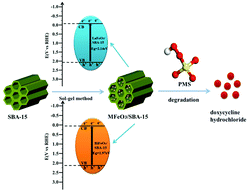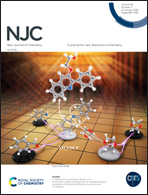Synthesis of MFeO3/SBA-15 (M = La or Bi) for peroxymonosulfate activation towards enhanced photocatalytic activity†
Abstract
MFeO3 (M = La or Bi) photocatalysts were synthesized via a sol–gel process. The MFeO3 photocatalysts showed lower photocatalytic activity for the degradation of doxycycline hydrochloride under visible light irradiation. After the MFeO3 nanoparticles were loaded in the channels of SBA-15, the photocatalytic activity of MFeO3/SBA-15 was enhanced by nine and two times compared to that of pure LaFeO3 and BiFeO3, respectively. The enhanced photocatalytic activity of the MFeO3/SBA-15 photocatalysts could be attributed to their larger surface areas. In order to further enhance the degradation efficiency for doxycycline hydrochloride, MFeO3/SBA-15 was used to activate peroxymonosulfate; the Vis/MFeO3/SBA-15/PMS system showed the best activity in the degradation of doxycycline hydrochloride, which was two and three times higher than that of the Vis/LaFeO3/SBA-15 and Vis/BiFeO3/SBA-15 systems, respectively. The influences of PMS dosage, pH value, temperature, natural organic matter, inorganic anions and doxycycline hydrochloride concentration on the degradation rates were investigated in detail. The PMS activation mechanisms induced by MFeO3/SBA-15 were examined by radical quenching, electron paramagnetic resonance tracing methods and photoluminescence spectral characterization. It was found that the photogenerated e−/h+ and the Fe(III)/Fe(II) redox pairs on the surface of MFeO3/SBA-15 could synergistically activate PMS to produce sulfate radical, and the sulfate radical was the main active substance.



 Please wait while we load your content...
Please wait while we load your content...